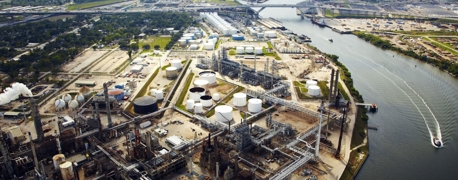Why the Williams Olefins Geismar Plant Explosion Happened
On the morning of June 13, 2013, a massive explosion rocked the Williams Olefins plant in Geismar, killing 2 men and injuring 167 workers. It also released 30,000 pounds of flammable petrochemical products and by-products into the air that day. The plant shut down for 18 months to make repairs and investigate the cause.
Arnold & Itkin has just successfully resolved one of the first lawsuits brought against Williams Companies, Inc. and Williams Olefins LLC (the child company who owned the plant) on behalf of four workers. For us, this case became a prime example of what industrial workers face and why they deserve better safety standards.
“Process safety management program weaknesses at the Williams Geismar facility during the 12 years leading to the incident caused the reboiler to be unprotected from overpressure.” – Chemical Safety Board
Today, the Chemical Safety Board released a study that may prevent workers from suffering the same injuries in the future. Part of the Chemical Safety Board’s mission is to thoroughly investigate the cause of disastrous events, and provide a plan for companies so they don’t happen again. Now that their findings are public, we believe it would benefit our readers to know exactly what occurred and why.
But first, a little background.
The History of the Geismar Plant
The Geismar plant was built in 1967 and passed ownership from company to company until 1999, when Williams Olefins bought it. It was originally designed to produce 600 million pounds of ethylene a year, but the plant was upgraded to double its production of ethylene (and produce propylene).
The desire for increased output is where this story really begins:
The movement from original design to upgraded capability requires an MOC, or a Management of Change. The evaluation outlines the hazards, procedures, and work required for the desired update. It should be written prior to an upgrade to ensure the safest possible transition, whether it involves equipment, personnel, or procedure.
In 2001, the plant made an upgrade to the reboiler system next to a propylene fractionator, or distillation column. The distillation column is a tall tower where a propane mixture will be heated, separating propane from propylene. The propane sinks to the bottom of the distillation column.
This 2001 upgrade is the key to understanding the explosion 12 years later.
Why the Reboilers Were Changed
Propylene production requires a powerful heat source to work—that’s what reboilers do. The reboilers are 24-foot long holding tanks where hot water will heat propane as it's sent into the fractionator. The hot water is contained in tubes in the center of the reboiler, while the propane flows around the tubes in order to heat up.
The water that enters the reboilers contains oily tar. Over the years, tar creates buildup in the tubes, making the system less efficient. This is known as “fouling.” Every few years, the plant would stop production and shut off the reboilers in order to clean them. To keep production moving, Williams decided to change the system.
In 2001, the Williams Olefins plant added valves to each reboiler—valves to stop the water from entering and leaving, and valves to prevent propane from entering or leaving. The idea was to isolate one reboiler and keep the other operating. That way, when a reboiler would foul, they could engage the other reboiler and disengage the one that needed cleaning. This would allow them to never cease production of propylene.
It came with a risk though: if the water valve was ever opened while the propane exit valve was closed, it would isolate the reboiler from its most crucial component—the safety valve at the top of the fractionator.
The Events on the Day of the Geismar Plant Explosion
On June 13, operations and maintenance personnel convened for their daily morning meeting. The plant manager noticed that the water flow to Reboiler A had declined throughout the day on June 12. The Olefins facility Operations Supervisor volunteered to troubleshoot the issue. He found that fouling was likely the issue.
He attempted to contact the Operations Manager to get the right personnel to take care of the issue. However, the manager was unavailable. The Operations Supervisor returned to the reboilers, where Reboiler B was on standby, as per procedure. He turned on the water valves in order to begin operation of the standby tank.
What he didn’t realize was that Reboiler B had no access to a pressure safety valve—and it was 65% full of liquid propane. As the hot water heated the propane, it expanded with nowhere to go. The pressure climbed to 1,200 psi when the tank ruptured. The fireball exerted enough force to launch a reboiler pipe 30 feet in the air.
The water valves were turned on at 8:33 am. It only took until 8:36 am for the tank to explode. The resulting fire took three and a half hours to put out, but the damage was done. A nearby operator who was working on the fractionator was killed on the scene—the Operations Supervisor sadly succumbed to his injuries the next day.
While there were many factors to this event, it can be boiled down to a few critical elements:
The First Mistake Was 12 Years Earlier
Rather than fully evaluate the risks posed by such an upgrade, Williams installed the valves, and wrote the MOC after the fact. The hazards of the upgrade were never reported or addressed, upgraded procedures were never written, and a deadly new risk flew under the radar.
The Reboiler Should Have Never Ignited
One new procedure was written to ensure that the reboiler on “standby” was properly prepared—all valves would be shut, and the reboiler would be filled with nitrogen (a highly stable gas). There it would sit until the other reboiler fouled. However, one important fact was left out: the block valves were known to leak.
While these valves leaked within industry regulations, Reboiler B slowly filled with propane during the 16 months it was offline and displaced the nitrogen. What should have been a tank of inert gas was instead a pressure bomb. In addition, the Williams Olefins plant had no tools with which to monitor what was inside the reboiler.
The Repair Was Completed Incorrectly
In 2006 and 2008, internal and external sources recommended the same thing regarding the reboilers: installing car sealing open reboiler block valves, which would give the tanks an open path to pressure relief. In 2010, the car seal installation was applied…but to only the active reboiler, which defeated the purpose of the recommendation in the first place. Again, an MOC was never performed for the installation.
In 2011, a Process Hazard Assessment tragically reported by mistake that both reboilers were car sealed when they were not.
No Action Was Taken Upon Discovering the Mistake
In May 2012, only a year before the fated explosion, the engineering records coordinator for the Olefins facility discovered that only the active reboiler was car sealed. The records were updated, but plant management approved the change regardless—even though the full repair was never completed.
There were many moments where this crisis could have been prevented. Events had to align in a specific way for a disaster to occur—that’s perhaps why the explosion occurred 12 years after the upgrade. There’s no use in speculating what could have happened or what might have happened, but even the absence of the Operations Manager that morning tempts readers to believe this explosion was fate.
It wasn’t fate. It was negligence.
The confluence of these elements—of not acting on safety recommendations, of treating safety regulations as an after-the-fact obligation rather than a legitimate tool, of not responding to the findings of their own employees—is what led to the explosion. Simple, human mistakes. Poor safety culture will always lead to preventable tragedy, whether it takes 2 weeks or 20 years. It doesn't make the result any less heinous.
Ultimately, that’s the lesson the Chemical Safety Board wants to teach companies. Safety protocol isn’t an obstacle to overcome, it’s not a checklist to fulfill out of obligation, and it’s not something that needs to be outsmarted or outmaneuvered. It's the most important practice that a business could have.
Whether we acknowledge it or not, it’s the only thing keeping our workers safe.
- Categories


